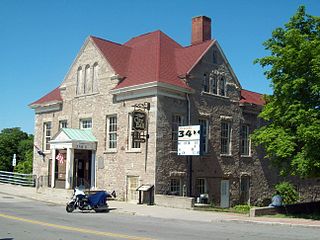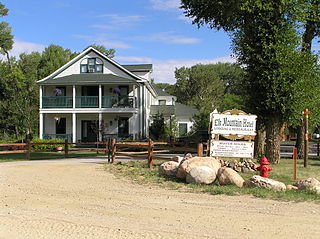
Pittsford is a village in Monroe County, New York, United States. The population was 1,355 at the 2010 census. It is named after Pittsford, Vermont, the native town of a founding father. This is the oldest village in New York, incorporated in 1827. The village, an Erie Canal community, is in the town of Pittsford. Pittsford is a suburb of Rochester, New York.

Bale Grist Mill State Historic Park is a California state park located in Napa County between St. Helena and Calistoga. The park is the site of a water-powered grist mill that was built in 1846 is one of only two water-driven mills remaining west of the Mississippi River.

South Pass City is an unincorporated community in Fremont County, Wyoming, United States. It is located 2 miles (3 km) south of the intersection of highways 28 and 131. A former station on the Oregon Trail, it became a ghost town after later gold mines were closed. The entire community is listed on the National Register of Historic Places. The closest town is Atlantic City.

Belmont is a ghost town in Nye County, Nevada, United States along former State Route 82. The town is a historic district listed in the National Register of Historic Places. It is Nevada Historical Marker number 138.

Esterhazy is a town in the south-eastern part of the Canadian province of Saskatchewan, 83 kilometres (52 mi) south-east of Yorkton along Highways 22 and 80. The town is in the Rural Municipality of Fertile Belt No. 183.

Potter's Mill is a tavern and bed and breakfast establishment located in Bellevue, Iowa. The structure was formerly a gristmill, being the oldest in the state of Iowa, and as such it has earned national recognition. Potter's Mill is on the National Register of Historic Places, as well as being named a point of interest in the Silos & Smokestacks National Heritage Area.

This is a list of neighbourhoods in the urban core of Greater Sudbury, Ontario. This list includes only those neighbourhoods that fall within the pre-2001 city limits of Sudbury — for communities within the former suburban municipalities, see the articles Capreol, Nickel Centre, Onaping Falls, Rayside-Balfour, Valley East and Walden.

The Luethstrom–Hurin House is a historic residence in the city of Wyoming, Ohio, United States. Erected in the 1860s and profoundly modified before 1875, it was the home of two prominent businessmen in the local grain and flour industry, and it has been designated a historic site because of its architecture.

This list is of the properties and historic districts which are designated on the National Register of Historic Places or that were formerly so designated, in Hennepin County, Minnesota; there are 194 entries as of November 2024. A significant number of these properties are a result of the establishment of Fort Snelling, the development of water power at Saint Anthony Falls, and the thriving city of Minneapolis that developed around the falls. Many historic sites outside the Minneapolis city limits are associated with pioneers who established missions, farms, and schools in areas that are now suburbs in that metropolitan area.

The Wyoming Army National Guard Cavalry Stable in Newcastle, Wyoming was built between 1933 and 1936 for the Wyoming National Guard's horses. It is the last National Guard cavalry stable in Wyoming. It has been used as the Anna Miller Museum by the Weston County Historical Society since 1966.

The Sheridan Flouring Mills, is an industrial complex in Sheridan, Wyoming. The mills were a major component of the economy of north central Wyoming, providing collection, storage and milling of locally produced wheat and other grains into flour and other milled products. The mill was established by Captain Scott W. Snively in the early 1890s. The Sheridan Milling and Manufacturing Company was sold to J.W. Denio in 1903, who operated the mill on Broadway Avenue near downtown Sheridan. A catastrophic fire destroyed that mill in 1919, resulting in the purchase of a new location on Coffeen Avenue and construction of a much larger mill.

This is a list of the National Register of Historic Places listings in Weston County, Wyoming. It is intended to be a complete list of the properties and districts on the National Register of Historic Places in Weston County, Wyoming, United States. The locations of National Register properties and districts for which the latitude and longitude coordinates are included below, may be seen in a map.

Benjamin C. Moore Mill is a historic flour mill, waterworks, and city hall building located at Lockport in Niagara County, New York. It is a stone structure built in 1859–60, as a flour mill for the Benjamin C. Moore Company. In 1864, Dwight Keep constructed this stone structure that was originally the Benjamin Moore Company Mill. Around 1884, it was converted from a flour mill, to one of the first water pumping plants in America. Within the basement of the Moore building, two of Birdsill Holly's pumps were installed, one pushing 3 million gallons of water and the other pushing 5 million, each utilizing the waterpower from the Mill Race. In 1893, the rear addition was constructed and the building was converted for use as city hall for the City of Lockport and was used as city hall until 1974, when the new city hall opened. It was listed on the National Register of Historic Places in 1973.
The Fort Laramie Three-Mile Hog Ranch was built to serve as a social center away from the soldiers' post at historic Fort Laramie, a 19th-century military post in eastern Wyoming. It became notorious as a place for gambling and drinking, and for prostitution, with at least ten prostitutes always in residence. The location is notable as an example of one of only a few military bordellos still standing in the United States by 1974, the time of its nomination to the National Register of Historic Places. The Fort Laramie site was one of a number of so-called "hog ranches" that appeared along trails in Wyoming.

The Newcastle Commercial District in Newcastle, Wyoming comprises the commercial center of this isolated Wyoming town. The town developed along the Burlington and Missouri Railroad in the late 1880s, with the commercial district taking shape between 1890 and 1952. The district includes twenty-three buildings, primarily commercial buildings, including two properties that are separately listed on the National Register of Historic Places: the Weston County Courthouse and the Newcastle Main Post Office. All of the buildings are considered "contributing properties" to the historic district.

Wyoming Mercantile, also known as the Aladdin General Store is a preserved small-town general store in Aladdin, Wyoming. The store, which remains in operation, was built in 1896 by Amos Robinson as Wyoming Mercantile. Robinson died the same year, and the store went to Mahlon S. Kemmerer, who placed his properties, including the Wyoming and Missouri Valley Railroad, under the Wyoming Mercantile umbrella. Railroading continued until 1927. The store has continued, serving as a post office, bar, freight station and gas station.

The Albers Brothers Milling Company building is a historic mill and contemporary office building located on the banks of the Willamette River in Portland, Oregon, United States. In the early decades of the 20th century, the German-immigrant Albers brothers built the largest flour and feed milling enterprise on the West Coast, headquartered in Portland and comprising operations in four states. This combined milling, warehousing, shipping, and office facility, built in 1909–1911, is the oldest remaining flour or feed mill in the city. The silos built into the south elevation of the building are painted with representations some of the mill's products as advertisements.

The Elk Mountain Hotel, also known as the John S. Evans Hotel, Mountain View Hotel and Grandview Hotel was built in 1905 in Elk Mountain, Wyoming on the bank of the Medicine Bow River. The two-story wood-frame building was built next to the 1880 Garden Spot Pavilion, a dance hall that was a social center in an otherwise isolated portion of Wyoming. The hotel was built by John Evans, the owner of the Elk Mountain Saloon, who in 1903 had acquired the Pavilion. Evans catered to the mining trade through the 1930s. By that time better roads allowed tourism to increase, and the hotel provided accommodation to hunters and tourists. Evans sold the property in 1947 to Mark and Lucille Jackson, who remodeled the hotel and the pavilion.

The Cheyenne Flour Milling Company, also known as the Standard Oil Company and Salt Creek Freightways, is an early warehouse building in Cheyenne, Wyoming. The structure was built in 1927 to house goods brought to and from Cheyenne by the Union Pacific Railroad in an industrial section of Cheyenne as a flour mill, replacing structures that had performed similar functions since 1915. By 1931 the building was shared by a warehouse for electrical parts for the Mountain States Telephone and Telegraph Company, a potato chip factory and a chemical products company. In 1937-38 the Standard Oil Company started to use the warehouse for bulk petroleum products storage, continuing to 1963. From 1963 the building was used by Salt Creek Freightways, which had shared use from 1936. In 1973 it became a plumbing parts warehouse, and by 2003 was owned and used by a general contractor.



















